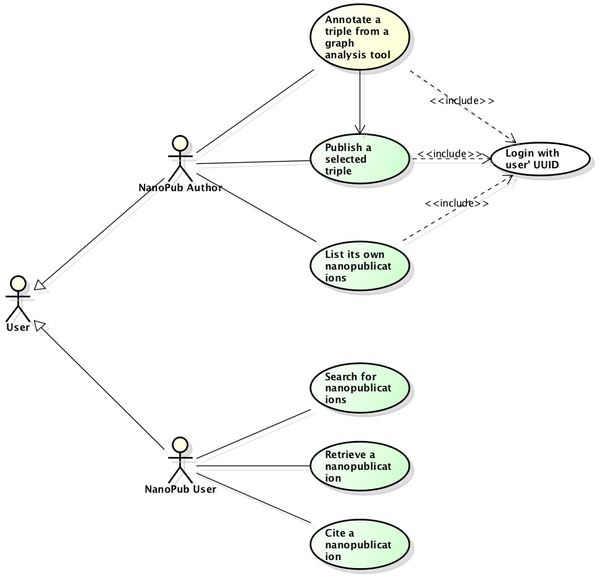| Page Properties | ||||||||||||||||||
|---|---|---|---|---|---|---|---|---|---|---|---|---|---|---|---|---|---|---|
|
...
From the usage scenarios described in Section 2.1, the use cases depicted in Figure 1 have been derived.
Figure 1 - Use cases |
The actors of the use case are divided in two types of users, namely, the NanoPub Author and the NanoPub User. While the former interacts with the system for the purpose of annotating an assertion, publishing the assertion or managing the assertions he published, the later consumes the published assertions by means of searching, retrieving and citing the assertions.
...
From the use cases described in the last session, we have decided to split the expected functionality of the system in two separate applications, namely, ORKA and NanoPub Store. ORKA is responsible for providing support to users who want to annotate a triple originated from a graph analysis tool by changing the triple's predicate. The edited triple is then transformed into a nanopublication adding the provenance of the author and keeping the relationship with the original triple. The NanoPub Store is responsible for storing the nanopublications created in the Triple Annotator as well as allowing users to search for stored nanopublications and cite them.
Figure 2 - General architecture of ORKA and NanoPub Store applications |
Figure 2 depicts the general architecture of ORKA (yellow) and NanoPub (green) applications. The applications have been divided in the following three main integrated but independent layers:
...
Triple citation
Assertion discovery
Attaching evidence to an annotation
Knowledge graph annotations are more valuable in terms of reusability if the annotator can provide supporting evidence. Here we focus on evidence taken from scientific literature, although other sources of supporting evidence may exist: databases, technical reports, electronic lab notebooks, etc. Yet another category consists of (relatively) weak types of evidence: like-buttons, vote up/down, etc.
Here we propose several scenarios of literature-based evidence based on the PubAnnotation community framework.
Scenario 1: cite a document fragment
- user provides PMID
- ORKA retrieves abstract from PubAnnotation
- user selects a fragment (words or sentences) that support his annotation
- ORKA records the PubAnnotation fragment URI as supporting evidence in the nanopublication
Scenario 2: cite an existing annotation
- user provides PMID
- ORKA shows embedded TextAE (abstract with highlighted annotations)
- user selects a PubAnnotation-annotation
- ORKA records the PubAnnotation annotation URI as supporting evidence in the nanopublication
Scenario 3: create and cite annotation (extension of Scenario 2)
- if none of the existing annotations are suitable evidence:
- user creates a new PubAnnotation-annotation in TextAE (consider adding step-by-step guidance)
- proceed as in S2
Notes
- Note the difference between “ORKA annotations” (curator says relation X should actually be Y with evidence Z) and “PubAnnotation annotations” (essentially just markup of entities and relations in the text). In this proposal evidence for the former type of annotation is provided by a reference to the latter.
PubAnnotation supports markup of relations between entities: Cancer “caused by” Smoking. In PubAnnotation, projects containing entity-type annotations are in the majority. Perhaps we could consider a process where ORKA users follow a step-by-step wizard to identify their evidence: 1) select subject term, 2) select object term and 3) select predicate term.
The previous note’s suggestion as well as S3 create new content that may be pushed into PubAnnotation.
PubAnnotation is still in active development: PubMed/PMC corpora are not complete, many annotation contributions are not yet public. However, PubAnnotation will likely scale up in the near future.
- In S2 we want a URI to refer to an individual annotation: currently not supported by PubAnnotation. In discussion with PubAnnotation developers to add this feature.
PubAnnotation aims to store annotations, but its community also develops standard APIs for uniform access to on-the-fly annotation webservices. These may prove useful if ORKA users can not find the entities that make up their evidence.
We have evaluated other annotation services like Domeo (Paolo Ciccarese) and Utopia (Steve Pettifer). However, PubAnnotation seems to offer the most straight-forward possibilities for integration with ORKA. In any case, re-use and interoperability of created annotations between the three platforms should be relatively easy (use of APIs and OA ontology).
Assumptions
Requirements
| # | Title | User Story | Importance | Notes |
|---|---|---|---|---|
| 1 | ||||
...

